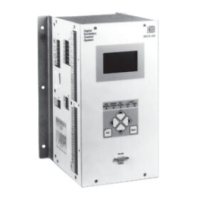DECS-200 BESTCOMS Software 5-21
Power Factor Step Response, Remove Steps.
Removes the last setpoint index created.
Power Factor Step Response, PF Setpoint Value.
This read-only field indicates the reactive power
setpoint established on the var/PF tab of the Setting Adjustments screen. If a step response setpoint
change has been made from this screen, the actual setpoint value for the regulator will differ from this
read-only indication.
Power Factor Step Response, Step Value Change PF Value.
Provides one of two methods for changing
the power factor setpoint and observing the generator response. (The other method consists of adjusting
the PF Step Response Settings dial.) Once the desired value is entered, the value is sent to the DECS-
200 by clicking the Send PF Value to DECS button. When clicked and held, the button color changes to
red and the button label changes to “Index 1”. Upon release of the button, the new power factor value is
sent to the DECS-200 and the PF setpoint for the power factor regulator. If the specified PF value is
outside the range limit, a dialog box appears and shows the acceptable values for the step response.
Changing the var setpoint through the PF Value field does not change the dial indicator.
The pointer of the PF Step Response Settings dial can be clicked and dragged to the approximate,
desired setting. The setpoint can then be fine tuned using the up and down scrolling buttons of the PF
Value window.
Power Factor Step Response, Step Value Change Index.
Up to three power factor step-response
setpoints (indexes) can be activated. An index is created by using the methods described in the previous
paragraphs. Index 2 is added by clicking the Add PF Step button. (It may be necessary to drag the red
Index 1 pointer out of the way to access the yellow index 2 pointer.) When the Send PF Value to DECS
button is clicked and held, the button color changes to yellow and the button label changes to “Index 2”. A
third index is added in the same manner as index 2, but the third index color is blue.
Power Factor Step Response, PF.
This read-only field indicates the value of the regulated power factor
level. The other three fields are described in the corresponding tab setting descriptions.
Alarm Signals.
During step response analysis, nine alarm indicators are available to indicate system
alarms. A list of the indicators is provided under
Analysis, AVR
. Alarm annunciations are updated
approximately once every second.
Protection/Relay
The Protection/Relay screen consists of five tabs labeled Options, Settings, Gain, Relay #1, #2 Logic,
Relay #3 Logic, and Relay Settings. To view the Protection/Relay screen, click the Protection button on
the tool bar or click S
creens on the menu bar and click Protection/Relay.
Options
Options tab settings are illustrated in Figure 5-25 and described in the following paragraphs.
Protection.
DECS-200 protection functions are enabled and disabled using these settings. DECS-200
protection functions include generator overvoltage, exciter field overvoltage, open exciter diode, loss of
field, generator undervoltage, exciter field overcurrent, and shorted exciter diode. When a protection
function is enabled or disabled, the change is sent immediately to the DECS-200.
Loss of Sensing Voltage, LOS.
Enables and disables the loss of sensing function.
Loss of Sensing Voltage, Time Delay.
Sets the time delay between when the DECS-200 detects a loss of
sensing voltage and when the alarm annunciates and the output relay actuates (if programmed). A setting
of 0 to 30 seconds may be entered in 0.1 second increments.
Loss of Sensing Voltage, Balanced Level.
When all phases of sensing voltage decrease below this
setting, the loss of sensing voltage time delay begins timing out. A setting of 0 to 100% (of nominal) may
be entered in 0.1% increments.
Loss of Sensing Voltage, Unbalanced Level.
When any one of three phases of sensing voltage decreases
below this setting, the loss of sensing voltage time delay begins timing out. This setting applies to three-
phase sensing applications only. A setting of 0 to 100% (of nominal) may be entered in 0.1% increments.
Loss of Sensing Voltage, Transfer to FCR Mode.
Enables and disables a transfer from AVR mode to FCR
mode when a loss of sensing voltage condition occurs.

